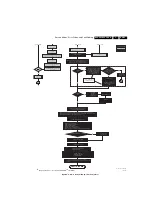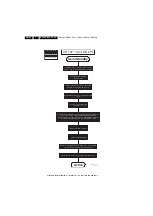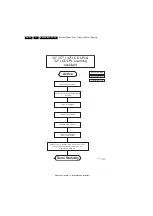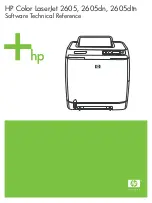
Service Modes, Error Codes, and Fault Finding
EN 32
BJ2.4U/BJ2.5U LA
5.
5.4
Service Tools
5.4.1
ComPair
Introduction
ComPair (Computer Aided Repair) is a service tool for Philips
Consumer Electronics products. ComPair is a further
development on the European DST (service remote control),
which allows faster and more accurate diagnostics. ComPair
has three big advantages:
1.
ComPair helps you to quickly get an understanding on how
to repair the chassis in a short time by guiding you
systematically through the repair procedures.
2.
ComPair allows very detailed diagnostics (on I
2
C level) and
is therefore capable of accurately indicating problem areas.
You do not have to know anything about I
2
C commands
yourself because ComPair takes care of this.
3.
ComPair speeds up the repair time since it can
automatically communicate with the chassis (when the
microprocessor is working) and all repair information is
directly available. When ComPair is installed together with
the Force/SearchMan electronic manual of the defective
chassis, schematics and PWBs are only a mouse click
away.
Specifications
ComPair consists of a Windows based fault finding program
and an interface box between PC and the (defective) product.
The ComPair interface box is connected to the PC via a serial
(or RS-232) cable.
For this chassis, the ComPair interface box and the TV
communicate via a bi-directional service cable via the service
connector(s).
The ComPair fault finding program is able to determine the
problem of the defective television. ComPair can gather
diagnostic information in two ways:
•
Automatically (by communicating with the television):
ComPair can automatically read out the contents of the
entire error buffer. Diagnosis is done on I
2
C/UART level.
ComPair can access the I
2
C/UART bus of the television.
ComPair can send and receive I
2
C/UART commands to
the microcontroller of the television. In this way, it is
possible for ComPair to communicate (read and write) to
devices on the I
2
C/UART buses of the TV-set.
•
Manually (by asking questions to you): Automatic
diagnosis is only possible if the microcontroller of the
television is working correctly and only to a certain extent.
When this is not the case, ComPair will guide you through
the fault finding tree by asking you questions
(e.g. Does the
screen give a picture? Click on the correct answer: YES /
NO)
and showing you examples
(e.g. Measure test-point I7
and click on the correct oscillogram you see on the
oscilloscope)
. You can answer by clicking on a link
(e.g.
text or a waveform picture)
that will bring you to the next
step in the fault finding process.
By a combination of automatic diagnostics and an interactive
question / answer procedure, ComPair will enable you to find
most problems in a fast and effective way.
How to Connect
This is described in the chassis fault finding database in
ComPair.
Caution:
It is compulsory to connect the TV to the PC as
shown in the picture below (with the ComPair interface in
between), as the ComPair interface acts as a level shifter. If
one connects the TV directly to the PC (via UART), ICs will be
blown!
Figure 5-17 ComPair interface connection
How to Order
ComPair order codes (US):
•
ComPair Software: ST4191.
•
ComPair Interface Box: 4822 727 21631.
•
AC Adapter: T405-ND.
•
ComPair Quick Start Guide: ST4190.
•
ComPair interface extension cable: 3139 131 03791.
•
ComPair UART interface cable: 3122 785 90630.
Note:
If you encounter any problems, contact your local
support desk.
5.4.2
LVDS Tool
Introduction
This service tool (also called “ComPair Assistant 1“) may help
you to identify, in case the TV does not show any picture,
whether the Small Signal Board (SSB)
or
the display of a Flat
TV is defective.
Since 2004, the LVDS output connectors in our Flat TV models
are standardized (with some exceptions). With the two
delivered LVDS interface cables (31p and 20p) you can cover
most chassis (in special cases, an extra cable will be offered).
When operating, the tool will show a small (scaled) picture on
a VGA monitor. Due to a limited memory capacity, it is not
possible to increase the size when processing high-resolution
LVDS signals (> 1280x960). Below this resolution, or when a
DVI monitor is used, the displayed picture will be full size.
Generally this tool is intended to determine if the SSB is
working or not. Thus to determine if LVDS, RGB, and sync
signals are okay.
How to Connect
Connections are explained in the user manual, which is packed
with the tool.
Note:
To use the LVDS tool, you must have ComPair release
2004-1 (or later) on your PC (engine version >= 2.2.05).
For every TV type number and screen size, one must choose
the proper settings via ComPair. The ComPair file will be
updated regularly with new introduced chassis information.
How to Order
•
LVDS tool (incl. two LVDS cables: 31p and 20p):
3122 785 90671.
•
LVDS tool Service Manual:
3122 785 00810.
•
LVDS cable 31p/FI -> 31p/FI (for JL2.1 chassis):
3122 785 90861.
•
LVDS cable 41p/FI -> 31p/FI (dual -> single LVDS):
3122 785 90831.
•
LVDS cable 20p/DF -> 20p/DF (standard with tool):
3122 785 90731.
•
LVDS cable 31p/FI -> 31p/FI (standard with tool):
3122 785 90662.
E_06532_021.eps
180804
PC
VCR
I2C
Power
9V DC
TO
UART SERVICE
CONNECTOR
TO
I2C SERVICE
CONNECTOR
















































